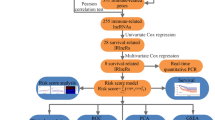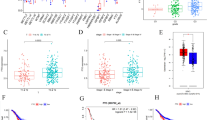Abstract
Purpose
MALAT1 is recognized as an oncogenic lncRNA in various malignancies. Here, the authors aim to explore the association of MALAT1 expression and prognostic implication in tongue squamous cell carcinoma (SCC).
Methods
The tongue tissues of 128 tongue SCC cases satisfying strict follow-up criteria and 28 normal cases were subjected to qRT-PCR assay for monitoring MALAT1 expression. Chi-square test was applied to explore the correlation between MALAT1 expression and clinicopathological features of tongue SCC. Kaplan–Meier analysis was used to calculate survival rates. Cox proportional hazard analysis was adopted to analyze the relationship between prognostic factors and patient survival.
Results
The expression of MALAT1 was upregulated in tongue SCC, compared to normal tongue tissues. The expression level of MALAT1 was correlated to differentiation and stage of tongue SCC, and high MALAT1 expression was associated with low disease-free survival and overall survival rates. Moreover, advanced tongue SCC patients with high MALAT1 level had lower disease-free survival and decreased overall survival rate than patients with low MALAT1 level. These results revealed that MALAT1 overexpression can be considered as a significant prognostic factor to independently predict the disease-free survival and overall survival rate of tongue SCC.
Conclusions
The expression level of MALAT1 is closely related with progression of tongue SCC. Furthermore, MALAT1 can serve as an independent biomarker for prognostic evaluation of tongue SCC.



Similar content being viewed by others
References
Kerawala C, Roques T, Jeannon JP, Bisase B (2016) Oral cavity and lip cancer: United Kingdom national multidisciplinary guidelines. J Laryngol Otol 130:S83–S89
Mitsudo K, Hayashi Y, Minamiyama S, Ohashi N, Lida M, Iwai T et al (2018) Chemoradiotherapy using retrograde superselective intra-arterial infusion for tongue cancer: analysis of therapeutic results in 118 cases. Oral Oncol 79:71–77
Liang J, Liang L, Ouyang K, Li Z, Yi X (2017) MALAT1 induces tongue cancer cells’ EMT and inhibits apoptosis through Wnt/β-catenin signaling pathway. J Oral Pathol Med 46:98–105
Steens SC, Bekers EM, Weijs WL, Litjens GJ, Veltien A, Maat A et al (2017) Evaluation of tongue squamous cell carcinoma resection margins using ex-vivo MR. Int J Comput Assist Radiol Surg 5:821–828
Cannon TL, Lai DW, Hirsch D, Delacure M, Downey A, Kerr AR, Bannan M, Andreopoulou E, Safra T, Muggia F (2012) Squamous cell carcinoma of the oral cavity in nonsmoking women: a new and unusual complication of chemotherapy for recurrent ovarian cancer? Oncologist 17:1541–1546
Yu Y, Zhang M, Liu J, Xu B, Yang J, Wang N et al (2018) Long Non-coding RNA PVT1 promotes cell proliferation and migration by silencing ANGPTL4 expression in cholangiocarcinoma. Mol Ther Nucleic Acids 7:503–513
Jiang L, Wan C, Guo Q, Yang SJ, Wu JD, Cai J (2018) Long noncoding RNA metastasis-associated lung adenocarcinoma transcript 1 (MALAT1) promotes renal cell carcinoma progression via sponging miRNA-429x. Med Sci Monit 24:1794–1801
Liang J, Liang L, Ouyang K, Li Z, Yi X (2017) MALAT1 induces tongue cancer cells’ EMT and inhibits apoptosis through Wnt/β-catenin signaling pathway. J Oral Pathol Med 2:98–105
Lin Q, Guan W, Ren W, Zhang L, Zhang J, Xu G (2018) MALAT1 affects ovarian cancer cell behavior and patient survival. Oncol Rep 39:2644–2652
Peng S, Cao L, He S, Zhong Y, Zhang Y, Shuai C (2018) An overview of long noncoding RNAs involved in bone regeneration from mesenchymal stem cells. Stem Cells Int 2018:8273648
Kim DH, Sung S (2017) Vernalization-triggered intragenic chromatin loop formation by long noncoding RNAs. Dev Cell 40:302–312
Gayen S, Kalantry S (2017) Chromatin-enriched lncRNAs: a novel class of enhancer RNAs. Nat Struct Mol Biol 24:556–557
Wang XQ, Dostie J (2017) Reciprocal regulation of chromatin state and architecture by HOTAIRM1 contributes to temporal collinear HOXA gene activation. Nucleic Acids Res 45:1091–1104
Mercer TR, Mattick JS (2013) Structure and function of long noncoding RNAs in epigenetic regulation. Nat Struct Mol Biol 20:300–307
McDaniel CS, Harper LL, Wild JR (1998) Cloning and sequencing of a plasmid-borne gene (opd) encoding a phosphotriesterase. J Bacteriol 170:2306–2311
Liu S, Liu X, Li J, Zhou H, Carr MJ, Zhang Z et al (2019) Long noncoding RNAs: novel regulators of virus-host interactions. Rev Med Virol 23:e2046
Zhang L, Zhou C, Qin Q, Liu Z, Li P (2019) LncRNA LEF1-AS1 regulates the migration and proliferation of vascular muscle cells by targeting miR-544a/PTEN aix. J Cell Biochem 23:1–9
Min L, Garbutt C, Tu C, Hornicek F, Duan Z (2017) Potentials of long noncoding RNAs (LncRNAs) in sarcoma: from biomarkers to therapeutic targets. Int J Mol Sci 18:E731
Zhang Z, Tang C, Dong Y, Zhang J, Yuan T, Li XL (2018) Targeting LncRNA-MALAT1 suppresses the progression of osteosarcoma by altering the expression and localization of β-catenin. J Cancer 9:71–80
Xie JJ, Li WH, Li X, Ye W, Shao CF (2019) LncRNA MALAT1 promotes colorectal cancer development by sponging miR-363-3p to regulate EZH2 expression. J Biol Regul Homeost Agents 33:331–343
Ren W, Guan W, Zhang J, Wang F, Xu G (2019) Pyridoxine 5’-phosphate oxidase is correlated with human breast invasive ductal carcinoma development. Aging (Albany NY) 11:2151–2176
Liu J, Tian W, Zhang W, Jia Y, Yang X, Wang Y et al (2019) MicroRNA-142-3p/MALAT1 inhibits lung cancer progression through repressing β-catenin expression. Biomed Pharmacother 7:108847
Zidan HE, Karam RA, El-Seifi OS, Abd-Elrahman TM (2018) Circulating long non-coding RNA MALAT1 expression as molecular biomarker in Egyptian patients with breast cancer. Cancer Genet 220:32–37
Sun L, Sun P, Zhou QY, Gao X, Han Q (2016) Long noncoding RNA MALAT1 promotes uveal melanoma cell growth and invasion by silencing of miR-140. Am J Transl Res 8:3939–3946
Author information
Authors and Affiliations
Corresponding authors
Ethics declarations
Conflict of interest
The authors declare that they have no conflicts of interest.
Additional information
Publisher's Note
Springer Nature remains neutral with regard to jurisdictional claims in published maps and institutional affiliations.
Rights and permissions
About this article
Cite this article
Hu, Y., Zheng, L., Zhang, J. et al. LncRNA-MALAT1 is a promising biomarker for prognostic evaluation of tongue squamous cell carcinoma. Eur Arch Otorhinolaryngol 277, 3155–3160 (2020). https://doi.org/10.1007/s00405-020-06023-6
Received:
Accepted:
Published:
Issue Date:
DOI: https://doi.org/10.1007/s00405-020-06023-6




